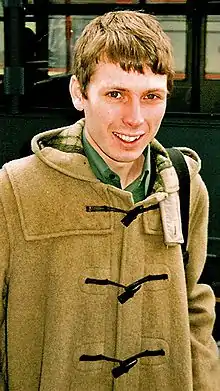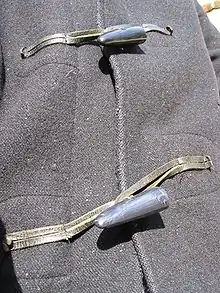Duffel coat
A duffel coat (also duffle coat) is a coat made from duffel, a coarse, thick, woolen material. The name derives from Duffel, a town in the province of Antwerp in Belgium where the fabric originated. Duffel bags were originally made from the same material. The hood and toggle fastenings proved popular, and the coat spread across Europe by the 1850s. By 1890 it was being supplied to the British Royal Navy. After World War II, the coats became available as government surplus stock and became popular, especially with students.


Description
There are many variations of duffel coat. The basic British style features:
- Genuine double weave woolen duffel fabric, lined with a woolly tartan pattern, or plain in the military version.
- Three or, later, four front wooden or horn toggle and leather fastenings.
- Two large outside patch pockets, with covering flaps on post-war versions.
- Originally knee length; shorter on later versions.
- A buttonable neck strap.
- Bucket hood with press stud adjustment. Later versions feature a neater "pancake" hood.
The toggle-fastenings are made to be easily fastened and unfastened while wearing gloves in cold weather. Current designs often feature imitation plastic buffalo horn. The original hood was oversized to allow room for a Naval cap. Early versions were knee-length but later ones were shorter.
History
The initial influence of what became the duffel coat, may have been the hooded Polish military frock coat, which was developed in the 1820s. It had the unusual features of a toggle closure and an integrated hood,[1] and by 1850 had spread through Europe.[2] In the 1850s, British outerwear manufacturer John Partridge developed the first version of the duffle coat.[3]
In the 1890s the British Admiralty purchased the coat in quantity for the Royal Navy from multiple manufacturers,[4] where it was referred to as the "convoy coat".[5] The navy issued a camel-coloured variant during World War I, The character played by Trevor Howard in the 1949 movie The Third Man, British Major Calloway, wears a standard issue Army duffel coat in numerous scenes.
The design of the coat was modified slightly and widely issued during World War II. It became known under the nickname "Monty coat". [6][7]
Large post-war stocks of low-cost military surplus coats turned the duffel into a ubiquitous item of British civilian clothing in the 1950s and 1960s, especially among students. The firm Gloverall purchased large quantities, and in 1954 started producing their own version using leather fastenings and buffalo horn toggles with a double-faced check lining, and many other modern versions copy some or all of those features.[8]
Today
.jpg.webp)
Today, the duffel coat is often made of Melton cloth, as opposed to modern duffel cloth which is a softer wool fabric with a distinct nap, used for high-end coats and parkas.
In Italy as well as in Greece, the duffle coat is called a Montgomery, after Field Marshal Sir Bernard Montgomery, who often wore one during World War II.[6][7]
In Popular Culture
In the BBC series, Jonathan Creek, part of the titular character's signature look includes a duffle coat, which was from actor Alan Davies' own closet.
References
- "Polish Frock Coat at around 1850", "...with toggles & hood."
- "Duffle coat history" Gentleman's Gazette
- "Duffle coat", Encyclopedia of clothing and fashion
- "Heritage, originalmontgomery.co.uk
- Taylor, Theodore, 2007. Battle in the Arctic Sea, Sterling
- The Monty at cabourn.com
- The classic we can't bear to be without at telegraph.co.uk